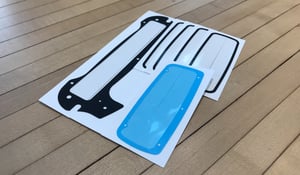In 2021, the global gaskets and seals market reached a US $60.2 billion value.
Yet, although grouped together, they are still named individual for a straightforward reason: Seals are NOT gaskets.
People often confuse these terms due to their similar functions, but what's the difference between a gasket and a seal?
Simply put, gaskets are a type of seal with properties that make them ideal for separating two liquids.
Although, because a gasket's material can alter its sealing capabilities, you'll first need to understand the basics of sealing to be fully informed.
What is a Seal?
Not the type at the boardwalk; we're talking about seals that form a dynamic barrier between two substances.
Seals are flat devices that stop one substance from seeping into the other side. The primary function of a seal is to prevent any leaks or contaminants.
SEAL APPLICATIONS
Seals are used in a variety of industries for several purposes:
- Protecting catheters, tubing, or IV bags from contamination and infection
- Airtight sealing in HVAC/R and HVAC systems keeps the environment clean and dry
- Protecting pumps, valves, conveyors, etc. from heat and harsh chemicals
The mouth of the seal forms a shape (typically a ring) over the gap where it remains thanks to its suction ability, i.e., by keeping lower air pressure on the inside rather than the outside.
As the high-pressure air tries to flow in to close the gap, the face of the seal grows more robust where it's fixed until it can press against the gap firmly enough to prevent fluid from entering.
TYPES OF SEALS
There are many different types of seals, including:
- Rotary seals
- Conventional seals
- Liquid sealants
- Mechanical seals
- Valve stem seals
- O-ring seals
Due to its flexibility, rubber is one of the most superior sealing materials. However, there are many other seal components on the market, depending on the type you want and what you plan on doing with it.
What is a Gasket?
A gasket is a static seal between two substances to prevent one side from leaking into the other.
Gaskets have many specialized uses, such as maintaining the pressure in a car's engine, shielding its trunk or side doors from moisture,
Sometimes gaskets are wedged between two flanges, squeezing them to create a more powerful suction. This technique is primarily used for gaskets made of rubber or other polymers due to their high flexibility.
TYPES OF GASKETS
Like seals, there are many different types of gaskets:
- Rubber
- Silicone
- EPDM
- Neoprene
- Foam
Choosing the right material for a gasket is crucial because it will determine its capabilities. Do you need something with high or low-temperature resistance? Do you need something stiff or flexible? What are you trying to gasket?
If you want to know more about how each material affects the ability of a gasket, check out our article on gaskets.
Key Differences
It's important to know that because gaskets are a type of seal, they share many of the same functions and properties. Still, understanding their differences is essential to finding the part you'd like to use.
Since we've gone over both topics individually, let's compare their advantages and disadvantages.
RANGE OF MOTION
One key difference is the motion of whatever the seal or gasket is planted in. Seals are ideal for objects that experience constant movement, while gaskets are built to be static.
You'll want to choose a seal if an object is in constant motion, like an engine or motor. The seal will protect the entire thing whether one or both sides are moving.
However, a gasket might be the better option if the object is static.
For example, a car's transmission uses seals to hold oil so its gears can move. However, the exhaust uses a gasket between the engine block and exhaust pipe to prevent leakage and ensure the flow of exhaust fumes.
EASE OF REPAIR
While damaged gaskets are relatively easy to replace, it can be challenging to repair a seal.
Seals aren't built to be replaced how gaskets are, so a broken seal may mean disassembling the whole device to gain access. On the other hand, Gaskets are expected to wear out in a few years, depending on the application.
Unfortunately, broken seals might cost a pretty penny due to the time required by the disassembly process. The good news is that without a pre-existing issue or another device malfunction, the odds of spontaneous seal failure tend to be relatively low.
GENERAL USE
Although both gaskets and seals are used to separate, in many instances, gaskets are used between liquids, while seals tend to exist between a solid and a liquid to prevent the liquid from seeping in.
This is not to say that gaskets or seals are limited to confining liquids; they are frequently used to contain gases.
Here are some general factors you should consider before selecting a seal or gasket:
- The fluid or gas that you're sealing
- The temperature it will endure and for how long
- The environment
Hopefully, now you better understand the difference between gaskets and seals. Still, if you've got questions about our capabilities regarding either, we'd be more than happy to answer them.
Regardless, we strive to become a resource that can help solve your project needs. Let us know if you need custom seals or gaskets, and we'll get you set up as best as possible.





